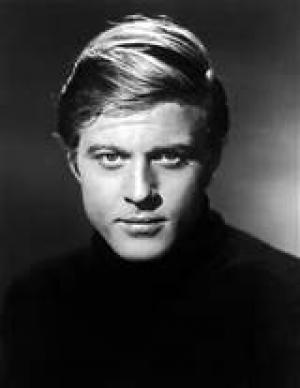The Ace Face
By Michael Roberts
All my life I've been dogged by guilt because I feel there is this difference between the way I look and the way I feel inside.
~ Robert Redford
Robert Redford came to notice via the well-worn path of TV and stage in New York in the late 1950’s and early 1960’s. He made some stand out appearances on the small box in shows like The Untouchables and Dr Kildare and was brilliantly cast as Death in the guise of a young, wounded police officer in a memorable Twilight Zone episode. After a series of smaller roles on Broadway he had a hit with Neil Simon’s Barefoot in the Park (directed by Mike Nichols) before landing a key screen role for producer Alan J. Pakula in Robert Mulligan’s Inside Daisy Clover, cast opposite Natalie Wood.
1966 proved a big year for Redford in films, finally hooking up with fine directors in Arthur Penn and the excellent The Chase, with Jane Fonda and Marlon Brando, and with Sydney Pollack, an acting friend who cast him in This Property is Condemned. Redford reprised his Broadway role on the big screen alongside Jane Fonda in Barefoot in the Park in 1967, but was largely unsatisfied with the predictable roles he was offered, typecast as an earnest, good looking, preppie type in ‘worthy’ vehicles, which led him to turn down the role of Benjamin in The Graduate preferring to wait for the right role to come along. He was primed and well positioned therefore when Paul Newman and George Roy Hill came knocking to cast him as the Sundance Kid, in favour of other, higher profile contenders such as Warren Beatty and Jack Lemmon in the serio-comic western classic Butch Cassidy and the Sundance Kid in 1969. The impact Redford had in the role made him a star, and he never forgot his debt to Newman, the pair becoming life-long friends, and Redford naming his widely successful Sundance Film Institute after the role.
The massive success of the Newman-Redford vehicle made the actor one of the most bankable actors on the planet, and he made the most of it by embarking on a stellar run over the next decade, making some 14 films, many of them modern classics. Redford had the happy knack of finding intelligent films that could find accepting audiences in the mainstream and still capture the zeitgeist, always looking to have quality directors and co-stars to strengthen the projects he worked on. He made two excellent films with Michael Ritchie, Downhill Racer and The Candidate, and re-teamed with George Roy Hill in The Great Waldo Pepper and with Hill and Paul Newman again in the box office phenomenon, The Sting. He made three more significant collaborations with his great friend Sydney Pollack, his most prolific collaborator over his career, with Jeremiah Johnson, The Way We Were and 3 Days of the Condor.
Redford took more control of his career by participating as a producer, as early as 1969 in Downhill Racer, and he used his box office clout to escalate his producing in the mid ‘70s, spectacularly so with All The President’s Men, inveigling Alan J. Pakula to direct and Dustin Hoffman to co-star. The film was a huge success and affirmed Redford’s impeccable liberal political credentials, as he championed leftist causes and issues like the environment and native Americans long before it was cool. He continued to star in quality films like Stuart Rosenberg’s prison drama Brubaker, and in Barry Levinson’s stylish baseball flick, The Natural.
Redford moved into directing in the latter half of his career, and immediately struck gold (and a Best Director Oscar) for the family drama, Ordinary People, starring Donald Sutherland and Mary Tyler Moore. He also had one of his biggest successes with Sydney Pollack again, in the grandly sweeping Out of Africa, starring opposite Meryl Streep. That film represented a kind of high point in Redford’s career arc and ever since he’s struggled to find roles that would consistently offer him a chance to connect with his muse. He started to take overtly commercial projects like Legal Eagles and Up Close and Personal, films that seemed to confirm him as a mainstream marketing brand, rather than as an actor intent on making interesting choices.
His late career directing projects yielded better results, with exemplary efforts like Quiz Show and A River Runs Through It proving intelligent and atmospheric. He started to find better roles for an actor his age in The Last Castle and in The Spy Game in the 2000’s and also did well as a director with the considered historical dramas The Conspirator and The Company You Keep. He was nominated for a Golden Globe for one of his best performances in the sea bound drama All Is Lost in 2013, and continues to be a leading light in Independent filmmaking in America through his Sundance Institute and its influential film festival.
Robert Redford had to counter the perception that his good looks allowed him an easy ride in an increasingly celebrity obsessed culture, cognisant that he had to work even harder to be taken seriously as an artist and activist. He consistently sought out quality mainstream products, occasionally lapsing into easy and slick commercial properties, but mostly providing fine entertainment, often with a kick in the tail. Redford’s best work helped to define an era, and his string of classics from Sundance to Out of Africa stands up still, as solid a streak as any screen actor can lay claim to. Redford distinguished himself as a director of note and an actor of range and depth, not as edgy as Nicholson or as bold as Hoffman, but able to bring insight and ambiguity to many a role, as well as being a fine (and over-looked) light comedy actor.
